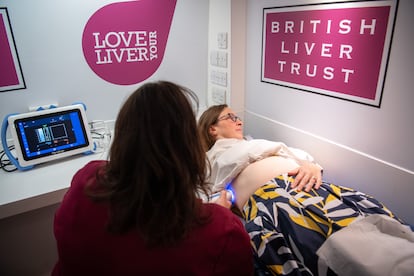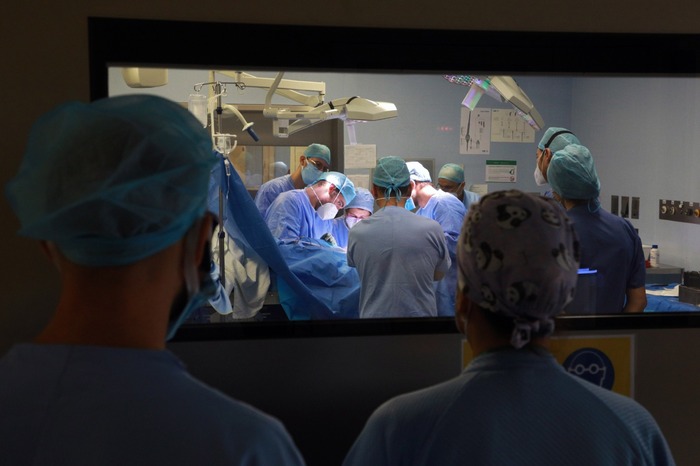British Liver Trust mobile liver scanning unit at the International Liver Congress in London in June.Steve Forrest/EASL
The healthiest amount of alcohol consumption is zero.
But hepatologists believe that is an unrealistic recommendation for the majority of the population.
At the International Liver Congress, which brought together some of the world's leading experts on the subject last week in London, they wanted to send a message to take care of this essential organ to people who are not willing to give up drinking completely: at least three days in a row a week without trying alcohol.
And a warning: it is not an isolated indication.
It must be accompanied by moderation and good nutrition the rest of the days.
Behind this advice is a worrying epidemiological reality: Europe has the highest rate of alcohol consumption in the world and more than half of end-stage liver disease is related to drinking, according to a joint report by the European Association for the Study of the Liver (EASL) and
The Lancet
.
Every year 287,000 people die on the continent from liver diseases, mostly preventable with healthy habits, and the trend is increasing: it is an increase of 25% compared to 1990.
Furthermore, liver diseases have a characteristic that differentiates them from others: they are prey on young and middle-aged people, especially among the most socially vulnerable population.
“This is in contrast to diseases caused by tobacco and obesity, such as lung cancer and type 2 diabetes, which typically cause deaths in people in their 60s and 70s,” the document says.
Data from the World Health Organization (WHO) show that liver diseases are the second cause of years of work lost in Europe, only behind coronary diseases.
With this reality in mind, Aleksander Krag, Deputy General Secretary of the EASL, calls for a decided reduction in alcohol consumption, its promotion and an increase in its prices.
“It's not that we tell people they can't drink anything;
[you can follow] very good rules: go three days without drinking every week, never consume more than five units of alcohol at one time and no more than 10 a week [one unit does not correspond to one drink: one glass of wine full equals three units;
a 333-milliliter beer (a can), is 1.5;
a shot of a high-proof drink, one unit],” explains Krag.
More information
The origin of acute childhood hepatitis is still a mystery after 894 cases, dozens of transplants and 18 deaths
Krag clarifies that these quantities, from the point of view of liver disease, may be tolerable, since the liver is an organ with a high capacity for regeneration, but that does not mean that they are recommended.
"You shouldn't drink a glass of wine thinking it's healthy, but because you like it."
The truth is that there are associated increases in the risk of certain cancers from any amount of alcohol, which is not only toxic, but also addictive.
For this reason, many health professionals are very opposed to making recommendations other than trying to drink as little as possible.
And if nothing is consumed, the better.
Juan Revenga, a food and health consultant, explains that "logically it is better to drink less" and rest for three days than not to do so, but he believes that promoting "moderate consumption" is an "entelechy".
“Ok, maybe a beer or a glass of wine a day is not going to crush your liver, but it has other risks.
Alcohol is addictive and gives you a feeling of well-being that, as soon as you drink, you tend to want a little more.
And, at the same time, it generates a habituation, because to find that sensation you need more and more.
In alcohol, the best quantity is zero”, he sums up.
Although there are differences of opinion on how to launch the message to reduce consumption, there is clear unanimity among experts on the advisability of doing so.
And for that, there are two very effective tools: raise the price and lower the promotion.
“It is well documented that the price of alcohol matters.
In Wales and Scotland they put a minimum price and consumption dropped overnight,” explains Krag.
This should not only apply to alcoholic beverages, but also to unhealthy food, in the opinion of the deputy secretary of the EASL, for which he asks politicians for differentiated taxes: “We know that vegetables are good, but many of our patients cannot afford them and they go straight to fast food.”
The other front that can help change habits is to regulate the promotion of both alcohol and unhealthy foods.
“There is a reason why companies have a huge advertising budget.
But why is it legal to advertise alcohol?” asks Krag.
He compares it to tobacco, for which promotion has been prohibited for years in almost all Western countries and whose packaging warns about the health dangers of its consumption.
“Why not implement these simple measures?
The alcohol industry won't like it, but it's about protecting the citizenry,” he reasons.
A disease that does not warn
One of the problems with liver disease is that it is often silent and does not give warning until it is too late.
"The majority of people with undiagnosed cirrhosis have normal blood tests," says the EASL and
The Lancet
report .
The WHO presented at the London congress, to which EL PAÍS attended invited by the organization, a new strategic line to fight against liver diseases with a focus on prevention.
“We need to bring diagnosis and treatment closer to the community.
Make mobile [liver] scans and blood tests [for liver markers] more accessible,” said Philippa Easterbrook, an expert with the agency's hepatitis program.
They want it to be easier to detect problems when they arise, that it is not necessary to go to a specialist or to the hospital, but that it can be solved in the health center or even in itinerant units that go through the neighborhoods.
It's something the British Liver Trust (BLT), a UK non-governmental organization focused on liver disease, has been doing for five years.
With some mobile units that scan the liver, they can know their state of health quite accurately.
It is a machine that was invented three decades ago to understand the curing of cheese.
You can measure if the inside is still soft and that determines if you need more rest.
Taken to the liver, it can calculate the degree of fibrosis of the organ.
If it is above certain levels, it is very likely that you will need a medical check-up to confirm it.
In the time it's been running, they've done more than 300,000 virtually random tests, in busy places in the UK.
In 20% of all of them the result was not optimal and they have been sent a letter recommending that they go to their doctor: it is not a diagnostic method, its promoters insist, but rather an easy, fast and cheap way of approaching what what happens in the liver
“Ninety percent of liver disease is preventable, and what increases the risk is two things: first, alcohol and, second, the metabolic risks associated with being overweight and type 2 diabetes,” says Vanessa Hebditch, spokesperson for the BLT.
"We know that if we locate the disease early we can stop the damage from progressing and in some cases even reverse it."





